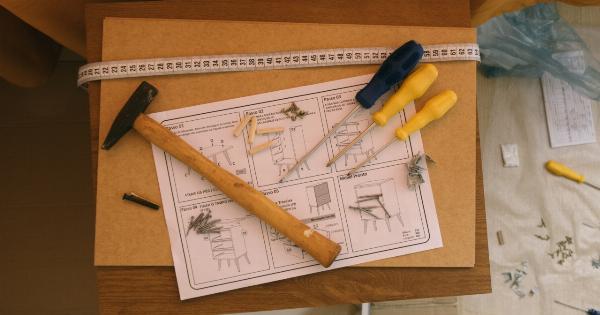Salt is a common yet essential ingredient in our daily lives. It enhances the taste of food and is used as a preservative in many processed and packaged products.
However, excessive salt consumption has been linked to various health issues, including high blood pressure, heart disease, and stroke. To address this concern, the Food and Drug Administration (FDA) has recently come up with new recommendations to reduce salt intake and promote healthier eating habits.
The Impact of Excessive Salt Consumption
High levels of sodium in the diet can lead to numerous health complications. One of the most significant concerns is the risk of developing high blood pressure or hypertension.
When we consume excess salt, the body retains water to dilute it, resulting in increased blood volume. This, in turn, raises blood pressure levels and puts strain on the heart.
Over time, high blood pressure can cause damage to the blood vessels and increase the risk of heart disease and stroke. It can also lead to other serious conditions such as kidney disease, osteoporosis, and stomach cancer.
New Guidelines from the FDA
Recognizing the detrimental effects of excessive salt intake on public health, the FDA has revised its guidelines to encourage individuals to reduce their sodium consumption.
The previous daily recommendation of 2,300 milligrams (mg) of sodium has now been lowered to 2,000 mg per day for the general population. Additionally, the FDA recommends that certain high-risk groups, including individuals with high blood pressure, diabetes, or kidney disease, limit their sodium intake to 1,500 mg per day.
In order to achieve these targets, the FDA advises consumers to be aware of the sodium content in the food they eat and to make healthier choices.
It is important to note that while table salt is a major contributor to overall sodium intake, a significant portion comes from processed and packaged foods. Therefore, reading food labels and being mindful of hidden sources of sodium is crucial.
Tips for Reducing Salt Consumption
Reducing your salt intake doesn’t have to be a daunting task. With some simple changes in your eating habits, you can lower your sodium consumption and improve your overall health. Here are some useful tips to get you started:.
1. Cook at Home and Use Fresh Ingredients
When you prepare your meals at home, you have complete control over the ingredients you use. Opt for fresh produce, lean meats, and herbs and spices to enhance the flavor of your dishes instead of relying on salt.
Experiment with different herbs and spices to create interesting and tasty combinations.
2. Read Food Labels
Take the time to read and understand food labels. Look for products that are low in sodium and choose options with reduced salt content whenever possible.
Be aware that terms like “sodium-free,” “low sodium,” and “reduced sodium” have specific definitions according to FDA standards, and it is essential to pay attention to these details.
3. Be Mindful of Hidden Sodium Sources
Many processed foods, such as canned soups, sauces, and condiments, contain high levels of sodium. Be aware of these hidden sources and opt for lower-sodium alternatives or consider making them from scratch.
Additionally, be cautious of high-sodium restaurant meals, as they often contain excessive amounts of salt.
4. Limit the Use of Salt in Cooking and at the Table
Gradually reduce the amount of salt you add to your meals during cooking and at the table.
Your taste buds will adjust to lower levels of salt over time, and you may even find that the natural flavors of the ingredients are more pronounced when not masked by excessive sodium.
5. Rinse Canned Foods
If you use canned beans or vegetables, a quick rinse can help reduce their sodium content by up to 40%. It’s a simple step that can make a big difference in your overall sodium intake.
6. Choose Fresh Fruits and Vegetables
Fresh fruits and vegetables are naturally low in sodium. Incorporate a variety of these nutritious options into your meals. They not only provide essential vitamins and minerals but also add vibrant colors and flavors to your plate.
7. Limit Processed and Packaged Foods
Processed and packaged foods are often loaded with salt to enhance flavor, improve texture, and increase shelf life. Try to limit your consumption of these items and focus on whole, unprocessed foods instead.
8. Be Cautious with Salty Snacks
Salty snacks like potato chips, pretzels, and popcorn are notorious for their high sodium content. Opt for healthier snack alternatives like nuts, seeds, or homemade snacks to satisfy your cravings without adding excessive amounts of salt to your diet.
9. Use Salt Substitutes Wisely
Salt substitutes often contain other minerals such as potassium, which can be beneficial for those with certain health conditions.
However, it is essential to use them in moderation and consult with a healthcare professional if you have any specific dietary restrictions or concerns.
10. Seek Support and Accountability
Reducing salt consumption can be challenging, especially when dining out or facing social pressures. Seek support from friends, family, or join a support group focused on healthy eating.
Having someone to share the journey with and be accountable to can make a significant difference in your success.
Conclusion
Reducing salt consumption is a vital step towards improving overall health and preventing various health issues. The FDA’s latest recommendations to limit sodium intake align with this important goal.
By making small changes in our eating habits, such as cooking at home, reading food labels, and being mindful of hidden sources of sodium, we can take control of our sodium intake and enjoy healthier lives.





























